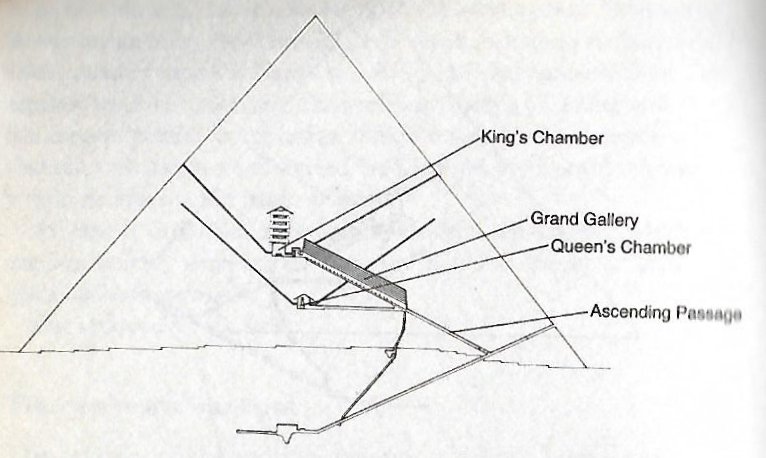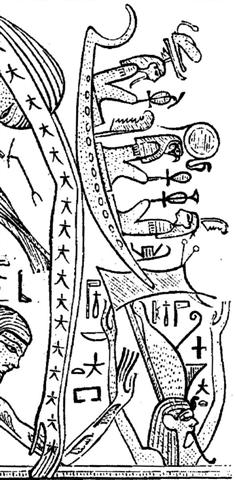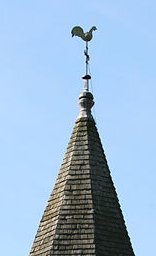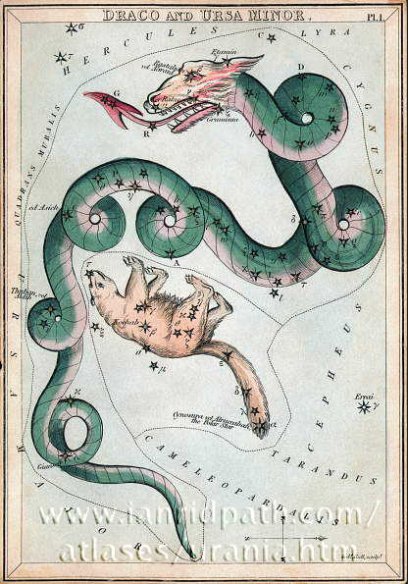411. A star which clearly was at the north pole before Polaris took over was Thuban:
... The star could be seen, both by day and night, from the bottom of the central passage of the Great Pyramid of Cheops (Knum Khufu) at Ghizeh, in 30° of north latitude, as also from the similar points in five other like structures; and the same fact is asserted by Sir John Herschel as to the two pyramids at Abousseir ... ... Sayce says that the great astrological and astronomical work compiled for the first Sargon, king of Agade, or Akkad, devoted much attention to this star, then marking the pole; as Tir-An-na, the Life of Heaven; Dayan Same; the Judge of Heaven; and Dayan Sidi, the Favorable Judge, - all representing the god Caga Gilgati, whose name it also bore. Brown applies these titles to Wega of the Lyre, the far more ancient pole-star, - but this was 14,000 years ago! - and cited for α Draconis Dayan Esiru, the Prospecting Judge, or the Crown of Heaven, and Dayan Shisha, the Judge Directing, as having the highest seat amongst the heavenly hosts. About 2750 B.C. it was less than 10´ from the exact pole, although now more than 26º; and as it lies nearly at the centre of the figure, the whole constellation then visibly swung around it, as on a pivot, like the hands of a clock, but in the reverse direction ... And the twins of equinoctial stars connected with Thuban could have been Alrisha and Hamal. I guess there should be a pair of them, for instance because Polaris had the pair Sheratan (Al Sharatain = the Pair of Signs) and Mesarthim. In the Egyptian net of the morning we can see a pair of 'fish eyes' (stars) sighted from the corner:
... The principal word for 'fish' in most Dravidian languages is min, which has an ancient homophone meaning 'star', both probably derivatives of the root min 'to glitter' ... Fish are actually unable to close their eyes, and the fact that 'when the fish sleeps it does not close its eyes' was noticed by ancient Indians. The dot-in-a-circle similar to that occuring among the trefoils of the Harappan priest-king´s robe is identical with the eye of the many small hare- and fish-shaped amulets discovered on the lower levels of Harappa ... The Mayan conception of Ursa Major could have included Thuban, because the Tail of Draco goes down in that region of the sky:
In order to make clear that Thuban no longer ruled at the top it certainly must have been necessary to create a memorable myth about his removal: ... the Palenque scribes repeated Creation again and described it as 'it was made visible, the image at Lying-down-Sky, the First-Three-Stone-Place'. Then we learned that five hundred and forty-two days later (1.9.2 in the Maya system), Hun-Nal-Ye 'entered or became the sky' (och ta chan). This 'entering' event occurred on February 5, 3112 B.C. The act of 'entering the sky' is recorded on another extraordinary painted pot.
This pot depicts one of the Hero Twins (One-Ahaw in the Classic texts and One-Hunaphu in the K'iche' Popol Vuh) and a great bird who is trying to land in a huge ceiba tree heavy with fruit. This mythical bird is Itzam-Yeh, Classic prototype of Wuqub-Kaqix, 'Seven-Macaw', of Popol Vuh fame. In that story, in the time before the sky was lifted up to make room for the light, the vainglorious Seven-Macaw imagined himself to be the sun. Offended by his pride, the Hero Twins humbled him by breaking his beautiful shining tooth with a pellet from their blowgun. This pot shows One-Ahaw aiming at the bird as he swoops down to land in his tree. As Itzam-Yeh lands on his perch, the text tells us he is 'entering or becoming the sky'. This particular 'sky-entering' is not the one mentioned in the Palenque text. It is the final event that occurred in the previous creation before the universe was remade. Before the sky could be raised and the real sun revealed in all its splendor, the Hero Twins had to put the false sun, Itzam-Yeh, in his place. If the date on this pot corresponds to that pre-Creation event, as we believe it does, then Itzam-Yeh was defeated in 12.18.4.5.0 1 Ahaw 3 K'ank'in (May 28, 3149 B.C.). After the new universe was finally brought into existence, First Father also entered the sky by landing in the tree, just as Itzam-Yeh did ...
On the C tablet glyph number 396 is 390 days after the first 6 glyphs in the text (and with 6 added to the 12 * 29 = 348 glyphs on side b it will become 354 = 12 * 29½), which presumably means these 6 glyphs were covering the difference between *70 (when Itzam-Yeh was defeated) and *64 (when Hyadum II had been at 0h). The number of tresses on the back side of Pachamama (World Mother) was 396.
Benetnash is η Ursae Majoris and the name suggest someone has died (been defeated, reached to his end):
... The name [Benetnash] derives from the Arabic phrase meaning 'The leader of the daughters of the bier'. The daughters of the bier, i.e. the mourning maidens, are the three stars of the handle of the Big Dipper, Alkaid, Mizar, and Alioth; while the four stars of the bowl, Megrez, Phecda, Merak, and Dubhe, are the bier ... When Benetnash was at the Full Moon it was a Sign that the Sun was at the right ascension line down from Polaris to the Belly of the Fish (Baten Kaitos). There was a new bird at the top, a new Sun had created the sky.
There was no interregnum between the tail of the Great Bear and the tail of the Little Bear:
This pair of bears ended together, but half the right ascension circle away from each other. However, in Roman times the ancient belief system broke and they fell down together. *26.6 (Polaris and Benetnash) * 71 - 1842 AD = 46.6 AD. ... In other words, the ancient Druidic religion based on the oak-cult will be swept away by Christianity and the door - the god Llyr - will languish forgotten in the Castle of Arianrhod, the Corona Borealis. This helps us to understand the relationship at Rome of Janus and the White Goddess Cardea who is ... the Goddess of Hinges who came to Rome from Alba Longa. She was the hinge on which the year swung - the ancient Latin, not the Etruscan year - and her importance as such is recorded in the Latin adjective cardinalis - as we say in English 'of cardinal importance - which was also applied to the four main winds; for winds were considered as under the sole direction of the Great Goddess until Classical times ... ... The father of Aemilianus the orator, to whom some of you have listened, was Epitherses, who lived in our town and was my teacher in grammar. He said that once upon a time in making a voyage to Italy he embarked on a ship carrying freight and many passangers. It was already evening when, near the Echinades Islands, the wind dropped and the ship drifted near Paxi. Almost everybody was awake, and a good many had not finished theire after-dinner wine. Suddenly, from the island of Paxi was heard the voice of someone loudly calling Thamus, so that all were amazed. Thamus was an Egyptian pilot, not known by name to many on board. Twice he was called and made no reply, but the third time he answered; and the caller, raising his voice, said, 'When you come opposite to Palodes, announce that Great Pan is dead.' On hearing this, all, said Epitherses, were astounded and reasoned among themselves whether it were better to carry out the order or to refuse to meddle and let the matter go. Under the circumstances Thamus made up his mind that if there should be a breeze, he would sail past and keep quiet, but with no wind and a smooth sea about the place he would announce what he had heard. So, when he came opposite Palodes, and there was neither wind nor wave, Thamus from the stern, looking toward the land, said the words as he heard them: 'Great Pan is dead'. Even before he had finished there was a great cry of lamentation, not of one person, but of many, mingled with exclamations of amazement. As many persons were on the vessel, the story was soon spread abroad in Rome, and Thamus was sent for by Tiberius Caesar. Tiberius became so convinced of the truth of the story that he caused an inquiry and investigation to be made about Pan; and the scholars, who were numerous at his court, conjectured that he was the son born of Hermes [Mercury] and Penelope [the wife of Odysseus] ...
"... He is said to have been the son of Penelope, Ulysses' wife, by Hermes who visited her in the form of a ram. A ram, not a goat. This is odd, because both Arcadian Pan and his Italian counterpart Faunus have goat legs and body. I think I see how that comes about. Pallas the Titan, the royal sea-beast, was the son of Crios (the Ram).
This means that the Pelopian settlers from Enete formed an alliance with the primitive Arcadians who worshipped Hermes the Ram, and acknowledged him as the father of their sea-beast King Pallas. Likewise the Aegeans - the goat tribe - formed an alliance with the same Arcadians and acknowledged Hermes as the father of their Goat-king, Pan, whose mother was Amalthea and who became the He-goat of the Zodiac ..." (The White Goddess)
|
||||||||||||||||||||||||||||||||||||||||||||||||||||||||||













